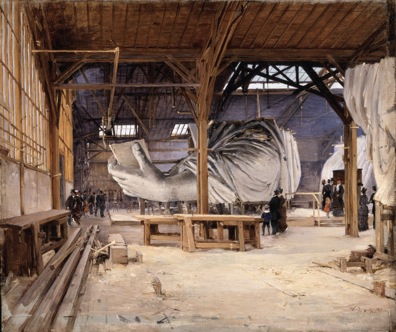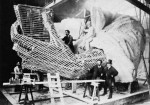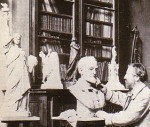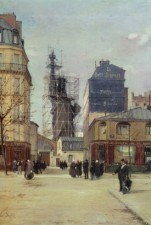

Paul-Joseph-Victor Dargaud
French, 1850-1921
The Statue of Liberty in Frederic-Auguste Bartholdi's Studio, Paris, 1884
oil on canvas
18 3/8 x 21 3/4 in.
SBMA, Museum purchase, 19th Century Endowment Funds and Suzette Davidson Art Acquisition Endowment
2001.36.2

Photo of Bartholdi in his studio, with a "mini statue" to his far left.
“We will not forget that Liberty has here made her home; nor shall her chosen altar be neglected."
President Grover Cleveland accepting the Statue of Liberty on behalf of the U.S., October 28th, 1886
"To the sculptor form is everything and is nothing. It is nothing without the spirit - with the idea it is everything." - Victor Hugo, May 13, 1885

Another painting by Dargaud of the "statue" being created outside the Gaget, Gauthier Foundry, Paris 1883.
COMMENTS
Paul Joseph Victor Dargaud's painting the Statue of Liberty in Frederic-Auguste Bartholdi's Studio, Paris (1884) commemorates the construction of Bartholdi's colossus Liberty Enlightening the World better known to Americans as the Statue of Liberty. Dargaud began exhibiting at the Paris salon in 1873, and until his death in 1921 he specialized in topographical scenes of belle epoque Paris. Like Manet and the Impressionists he was fascinated by the city and painted views of Paris that combine a topographer's eye for realist detail with an impressionist's sensitivity to the fleeting quality of modern life. A series of his Parisian views are in the Carnavalet Museum in Paris, one of which shows the Statue of Liberty fully assembled outside Bartholdi's studio.
Inspired on a trip to Egypt by the grandeur of the Pyramids and the Sphinx, Bartholdi imagined a monumental statue of Liberty that would be twice the size of the Sphinx. Liberty was fabricated in Paris at the workshop of Gaget, Gauthier-and Company at 25 rue Chazelles. Work began in 1875. Because of its size the statue was modeled in sections. The right arm bearing the torch was the first portion competed; it was shipped to the United States in 1876 in time for the nation's centennial. It was not until 1883 that the statue was completed, and on June 15, 1885, the Statue of Liberty - in 214 packing crates, arrived in New York harbor.
A contemporary photograph shows the wooden lattice armature over which a full-scale plaster model of Liberty was formed. Gaget, Gauthier and Company were experts in the art of repousse; a sculptural technique of hammering sheet metal inside molds 117 The copper sheets of the statue were hammered onto carved wooden templates. A sturdy intricate internal iron skeleton designed by the celebrated engineer, Alexandre-Gustave Eiffel, supported the statue's thin copper cladding. Darguad's view of the workshop represents the stage at which the plaster model for the statue's left hand and arm had been completed.
A gift of Suzette Davidson and Nineteenth-century Endowment Funds, Dargaud's painting, compliments the Museum's strength's in nineteenthcentury sculpture and like the Statue of Liberty itself, is a testament to French artistry and American political ideals.
- Ann Bermingham, Professor of the History of Art and Architecture, UCSB
SBMA CURATORIAL LABELS
Dargaud, a specialist in topographically accurate views of the fashionable boulevards of Paris, is
little known today, although he exhibited at the Salon from 1873 until his death. This painting,
one of his best-known works, represents the fabrication of the Statue of Liberty. Its sculptor,
Frédéric-Auguste Bartholdi, aspired to rival the sublime effect of such monuments as the
Pyramids and the Sphinx. Because of its scale, Bartholdi had to construct Liberty in sections, as
shown in this painting of the statue’s left arm. Although the right arm of the statue was shipped
to the United States in 1876 in time for the centennial, the entire statue was not completed until
1883.
- Ridley-Tree Reopening, 2021
